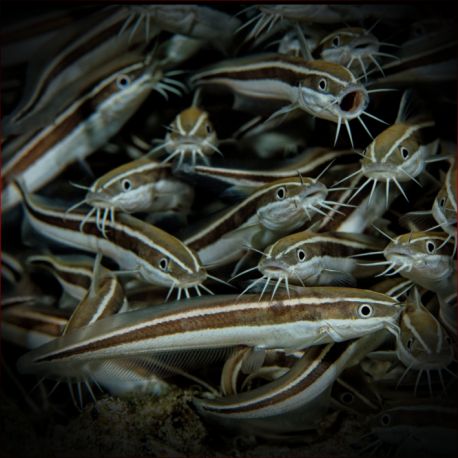More info
Datasheet
| Minimum Tank Size | 600 litres / 158.50 US gallons |
| Maximum Size | 32.0cm / 12.60inches |
| Reef Compatible | Reef safe with caution |
| Temperament | Peaceful |
| Temperature | 22.2°C / 71.96°F - 25.6°C / 78.08°F |
| Specific Gravity | 1.020-1.025 |
| Carbonate Hardness | 8-12 |
| pH | 8.1-8.4 |
General Description
The Striped eel catfish, scientifically known as Plotosus lineatus, is a member of the Plotosidae family. These fish exhibit a coloration shift from black when young to a brownish hue with white or yellow stripes as they mature. They possess poisonous spines near their dorsal and pectoral fins, making careful handling necessary due to the potential danger posed to humans if stung. This species typically grows up to 32.0cm in size and hails from the Indo-Pacific region, ranging from the Red Sea and East Africa to parts of Asia and Oceania.
Aquarium Suitability
Considered suitable for aquariums with caution, the Striped eel catfish is known to be venomous, posing a threat to small fishes, crustaceans, worms, snails, and other invertebrates. Their hunting behavior involves rummaging through the sand for food, which can result in cloudy water and disturbance of detritus within the tank. Regular monitoring and proper precautions are advised for their safekeeping.
Demands
The Striped eel catfish is classified as a hardy species, capable of adapting to a range of water conditions within specific parameters. They prefer a well-maintained environment with alkaline pH levels of 8.1-8.4, a water hardness (KH) of 8-12, a specific gravity (SG) of 1.020-1.025, and a temperature range of 22.2-25.6°C.
Care and Hardiness
With a peaceful temperament, these catfish thrive in shoals, displaying better behavior and activity levels when kept in groups. They require a minimum tank size of 600 liters to accommodate their schooling habits and potential growth. Feeding them a varied diet that includes fish, larger crustaceans, and small invertebrates several times a day is recommended for their overall well-being.
Reef Suitability
Considered reef safe with caution, the Striped eel catfish can coexist in a reef aquarium setup. However, vigilance is necessary to ensure they do not predate on smaller reef inhabitants or disrupt the delicate balance of the reef ecosystem.
Aquarium Setup
Setting up an aquarium for Striped eel catfish involves providing ample sandy substrate for them to forage and burrow. The tank should have sufficient hiding spots like caves or crevices to replicate their natural habitat. Maintaining good water quality, regular feeding schedules, and adequate space for a small to large shoal are essential considerations for their successful care.
Behaviour
In an aquarium setting, Striped eel catfish are known to remain hidden unless kept in a group, showcasing a more active and engaging demeanor when in the company of their own kind. Their scavenging nature and sand sifting behavior contribute to the overall ecosystem of the tank by helping clean up leftover food and detritus.
Feeding and Diet
Their diet should consist of a diverse range of foods, including fish, larger crustaceans such as shrimp and crabs, and small invertebrates like krill, mysis, and artemia. Feeding them multiple times a day is crucial, especially upon introduction to the tank, to ensure they receive adequate nutrition and do not deplete natural food sources too quickly.
Dimorphism
As Striped eel catfish mature, their coloration shifts from black to a brownish hue with prominent white or yellow stripes, showcasing distinct visual differences between juveniles and adults. These fish have the capability to reproduce in captivity, a process that requires a well-maintained environment and suitable breeding conditions.
Habitat and Distribution
The natural habitat of the Striped eel catfish includes coral reefs in the Indo-Pacific region, spanning from the Red Sea and East Africa to areas like Japan, Australia, and Micronesia. They are known to inhabit a variety of marine environments, occasionally venturing into freshwater settings in regions such as East Africa.

